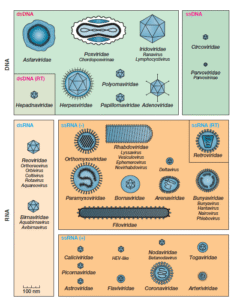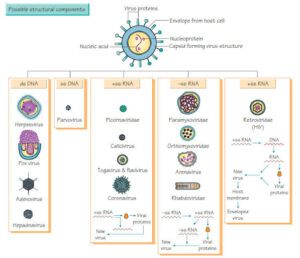Back to: MICROBIOLOGY 300 LEVEL
Welcome to class!
Hello brilliant one! I hope you’re feeling energised and ready to learn something new today. I’m truly excited to guide you on this learning journey—just picture me sitting right next to you, cheering you on every step of the way. Get comfortable, clear your mind, and let’s enjoy this moment of growth together.
Viral Structure And Classification
Have you ever wondered why sometimes, even with all the food and rest in the world, your body still falls sick from something as small as a sneeze from someone beside you? That’s often the work of viruses—those tiny invaders that can’t even survive on their own. Viruses may be invisible to the naked eye, but they are powerful enough to change how entire societies function—as we saw with COVID-19.

In this lesson, we will understand how viruses are structured and how scientists classify them. You’ll discover how something so small can have such a huge impact, not only on humans but also on animals, plants and even bacteria.
Structure of Viruses
Viruses are not like typical living cells. In fact, they are not considered living organisms because they cannot reproduce or carry out metabolism on their own. They must infect a host cell to become active.
A virus is made up of the following key components:
Nucleic Acid (Genetic Material): This could be DNA or RNA, but never both. This is like the virus’s instruction manual. It contains all the information the virus needs to replicate once it enters a host.
Capsid: This is a protective protein coat that surrounds the genetic material. It helps the virus attach to host cells and protects it from damage. The capsid is made up of repeating units called capsomeres.
Envelope (in some viruses): Some viruses, like HIV and Influenza, have an outer layer called an envelope, which is made of lipids and proteins. This envelope is usually borrowed from the host cell’s membrane during the virus’s release.
Spike Proteins: These are found on the surface of enveloped viruses. They help the virus identify and bind to the right host cell. Think of them like keys looking for the right lock to open.
Classification of Viruses
To make sense of the countless types of viruses, scientists classify them based on certain features:
Type of Nucleic Acid:
DNA viruses (e.g., Herpesvirus)
RNA viruses (e.g., Coronavirus)
Shape and Structure:
Helical viruses look like rods (e.g., Tobacco Mosaic Virus)
Icosahedral viruses are spherical (e.g., Adenovirus)
Complex viruses have more elaborate structures (e.g., Bacteriophages)
Presence or Absence of an Envelope:
Enveloped viruses (e.g., HIV)
Non-enveloped viruses (e.g., Poliovirus)
Host Range:
Animal viruses
Plant viruses
Bacterial viruses (bacteriophages)
Let’s imagine a virus like a mischievous thief. The thief (virus) carries instructions (nucleic acid) in a backpack (capsid) and sometimes wears a disguise (envelope). He can’t enter the building (host cell) without the right key (spike proteins). Once inside, he takes over the building’s machinery to make copies of himself and cause damage before escaping to infect more buildings.

For example, the Human Immunodeficiency Virus (HIV) has RNA as its genetic material, an envelope, and special spike proteins that help it bind to white blood cells.
Summary
- Viruses are non-living entities that need a host to replicate.
- Their basic structure includes genetic material (DNA or RNA), a protein coat (capsid), and sometimes a lipid envelope.
- They are classified based on the type of nucleic acid, shape, envelope presence, and host range.
Evaluation
- What is the main difference between DNA and RNA viruses?
- Explain the role of the capsid in a virus.
- Name two structural types of viruses and give examples.
- Why are viruses not considered living organisms?
- Describe how a virus infects a host using a simple analogy.
You’ve just done something amazing—navigating a complex topic with patience and curiosity. That’s how great scientists are made! Remember, at Afrilearn, we believe in your brilliance and we’re here to support your learning journey every step of the way. Keep shining bright, and I can’t wait to learn with you again in our next exciting class. You’ve got this!
